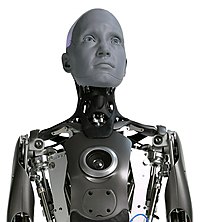
Photo from wikipedia
Balancing is a critical feature for a robot interacting with an unstructured environment. The balancing control should account for unknown perturbation forces that might destabilize the robot when performing the… Click to show full abstract
Balancing is a critical feature for a robot interacting with an unstructured environment. The balancing control should account for unknown perturbation forces that might destabilize the robot when performing the intended tasks. In the case of humanoid robots this challenge is higher due to the inherent difficulties of balancing a robot on two legs, resulting in a rather small footprint. Approaches for enabling a good balancing behavior on humanoid robots traditionally rely on whole-body balancing approaches. This letter extends a passivity-based whole-body balancing framework to guarantee the equilibrium of a humanoid robot while performing different interaction tasks where the (high) task forces acting on the robot are difficult to foresee. Instead of controlling the center of mass, the proposed controller directly uses information from the gravito-inertial wrench cone to guarantee the feasibility of the balancing forces. The performance of the approach is validated in a number of successful experimental tests.
Journal Title: IEEE Robotics and Automation Letters
Year Published: 2019
Link to full text (if available)
Share on Social Media: Sign Up to like & get
recommendations!